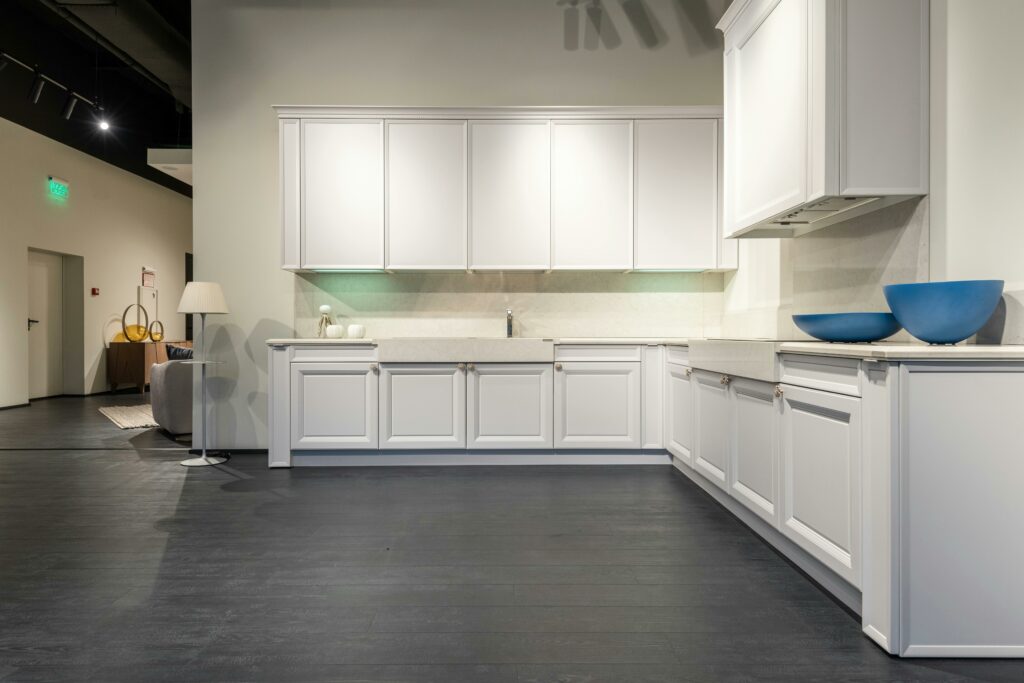The design and feel of your kitchen or bathroom can be entirely changed by renovating the cabinets. On the other hand, renovating cabinets might sometimes need a large cash investment. Making the right financial choices is important for ensuring that you can accomplish your goals without going over budget. We at Askin Cabinets understand that there are a variety of situations that our customers face from a budgetary standpoint That is why we made this article to help you budget your renovations more efficiently.

- Outline the Project’s Scope
The first step in creating a budget for your cabinet renovation is determining the project’s scope. Are you going to replace every cabinet, or are you only going to refinish or reface them? Do you want to add more storage or change the arrangement? Will you also be replacing the flooring, appliances, and countertops? You may more precisely estimate the total costs of the remodeling if you are clear about the extent of the work.
- Check the Current Cabinets
Before preparing your renovation, you should evaluate the state of your current cabinets. You might be able to save money by refinishing or refacing the cabinets rather than replacing them completely if they are physically sound. However, a complete replacement can be necessary if the cabinets are obsolete, deformed, or damaged.
- Choose Your Materials
The cost of the cabinets themselves is one of the biggest expenses in a renovation project for cabinets. The final budget will be greatly impacted by the material you select. Popular materials for cabinets include:
- Solid wood, such as maple, oak, or cherry: a more expensive but superior option that is incredibly sturdy and customizable.
- Wood veneers: Still aesthetically pleasing, but less expensive than solid wood.
- Laminate: An affordable solution that comes in a range of hues and designs.
- Thermofoil: Sturdy and water-resistant, ideal for kitchens and baths.
To determine which material best suits your needs in terms of cost and lifestyle, take into account each material’s strength, maintenance requirements, and visual appeal.
- Consider the Costs of Professional Design and Installation
For any cabinet restoration project, you’ll probably need to work with professional designers and installers unless you’re a skilled DIYer. These services can add a substantial amount to your entire cost, but they are necessary to guarantee a durable, high-quality outcome.
Depending on the experience of the designer and the complexity of the design, design fees normally account for 10% to 20% of the project’s overall cost. The complexity of the layout, the materials to be used, and the size of the project can all affect installation costs.
- Account for Additional Costs
You should include the following costs in your budget in addition to the price of the cabinets and professional services:
- Demolition and disposal: You must account for the expense of demolition and clear away any leftover debris if you’re taking out existing cabinets.
- Plumbing and electrical work: You might need to hire plumbers and electricians if you’re adding new appliances or changing the layout.
- Hardware and accessories: Don’t forget to budget for organizers, additional accessories, and cabinet hardware (handles, knobs, and hinges).
- Countertops: Take into account the cost of installation and materials if you’re replacing your countertops.
- Flooring: Make sure to account for the cost of materials and installation if you’re changing the flooring.
- Lighting: In bathrooms and kitchens, proper lighting is necessary. Think about how much new light fixtures or recessed lighting would cost.
- Appliances: Take into account the price of the new appliances as well as any adjustments required to make room for them if you’re updating your setup.
- Permissions and inspections: The cost of your project may increase if you need to arrange for inspections and get permissions, depending on its size.
- Make a Detailed Budget
It’s time to put together a comprehensive budget for your cabinet renovation project after you’ve taken into account every possible expense. Make a list of all the required parts and an estimate of how much they will cost first. A contingency reserve should be included in the overall budget, usually representing 10% to 20% of the total, to cover unforeseen costs that may occur throughout the project.
Ready to Renovate? Call Askin Cabinets for a Quote!
Setting up a budget for your ideal cabinets doesn’t have to be difficult. You may have an amazing renovation that fits your budget and improves your house for years to come with careful planning, setting priorities for your needs, and working with us at Askin Cabinets. For a quote and quality service for your renovations get in touch with us right now!
